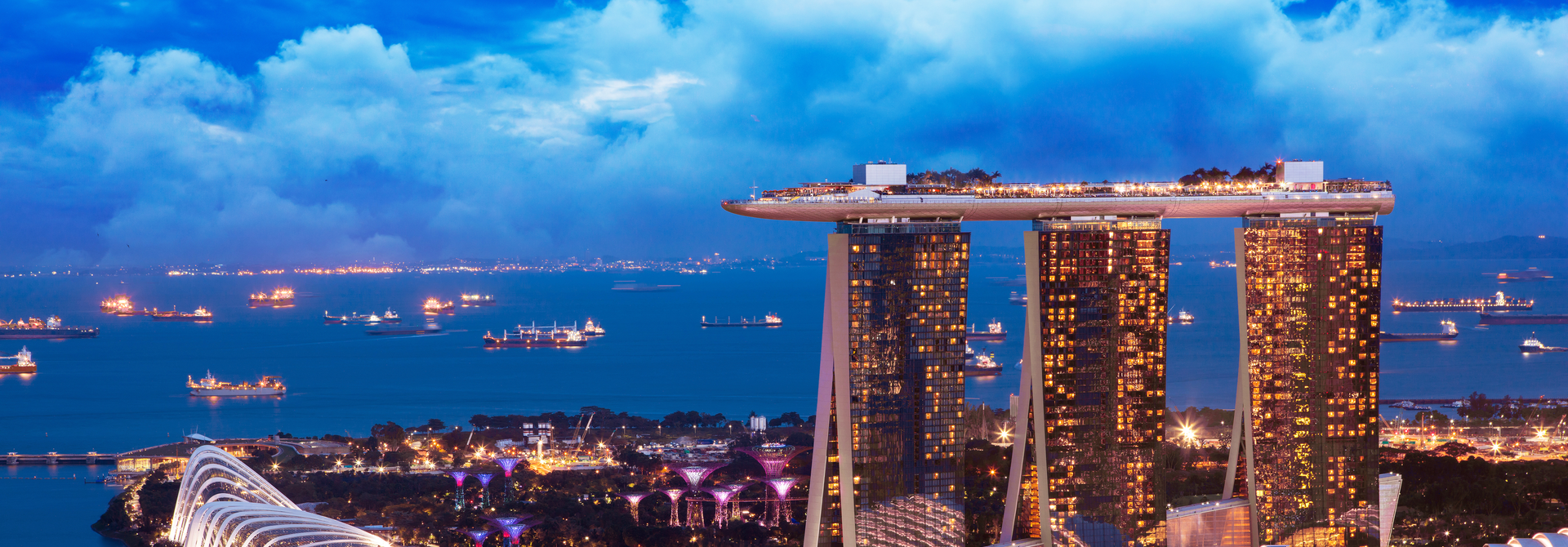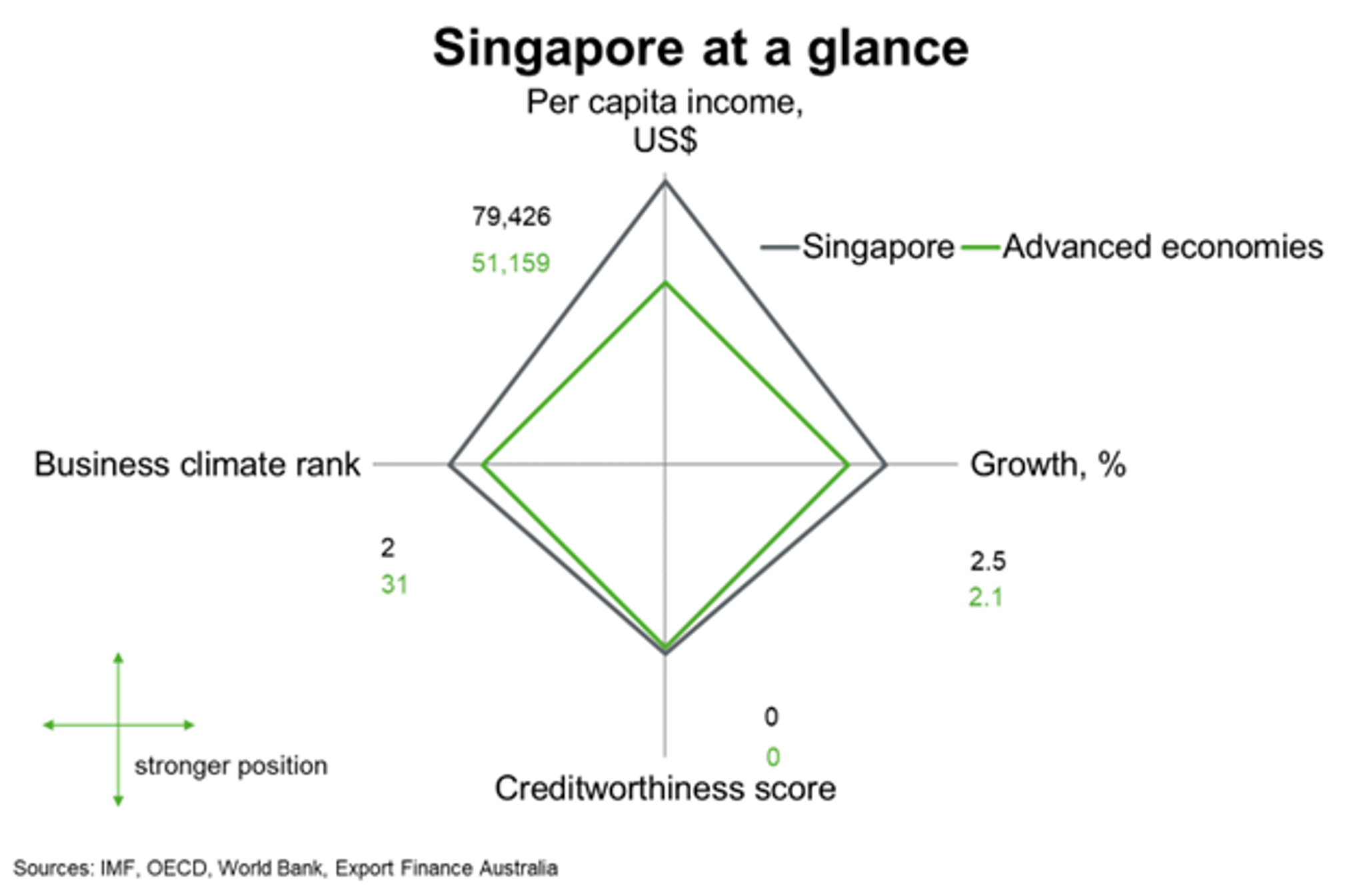
Singapore
Singapore
Last updated: February 2023
Singapore outperforms advanced economy peers on measures of income and the business climate. Low tax rates and a pro-business environment attract significant foreign direct investment and have helped the country become one of the wealthiest, on a GDP per capita basis, in the world. Creditworthiness is high, as is the case in many advanced economies. Growth prospects are slightly higher than advanced economy peers.

The above chart is a cobweb diagram showing how a country measures up on four important dimensions of economic performance—per capita income, annual GDP growth, business climate rank and creditworthiness. Per capita income is in current US dollars. Annual GDP growth is the five-year average forecast between 2023 and 2027. Business climate is measured by the World Bank’s 2019 Ease of Doing Business ranking of 190 countries. Creditworthiness attempts to measure a country's ability to honour its external debt obligations and is measured by its OECD country credit risk rating. The chart shows not only how a country performs on the four dimensions, but how it measures up against other countries in the region.
Economic outlook
A global slowdown due to high inflation and rising interest rates has hit Singapore’s key exports sector. Real GDP growth fell to 3% in 2022, from 7.6% in 2021 on lower manufacturing activity and a pullback in global demand for electronics, especially semiconductors. On the positive side, the services sector benefited from a robust recovery in tourism and strong household consumption.
The IMF forecasts growth to slow to 1.5% in 2023. Export-oriented growth will further weaken as global financial conditions tighten and Singapore’s major trading partners face an economic slowdown. This, alongside global consumers pivoting to spend more on services than goods, will slow manufacturing further in 2023. China’s border reopening should boost Singapore’s tourism sector and help keep unemployment low; international tourism arrivals are poised to reach pre-pandemic levels by the end of 2024.
Risks are tilted to the downside and are mostly external. The potential for further supply chain disruptions, even higher inflation and further interest rate hikes in advanced economies could contribute to weaker external demand for Singapore’s goods and services.
Longer-term challenges include an ageing population and mitigating exposure to environmental risks. But Singapore’s strong fiscal and external buffers and highly effective institutions provide authorities with significant scope to address these cyclical and structural challenges.

According to IMF data, Singapore’s GDP per capita was the sixth highest in the world in 2022, ahead of the United States (seventh) and Iceland (eighth). Per capita GDP is expected to reach US$100,000 in 2027. Authorities’ ongoing plans to invest further in human capital and pursue policies that transition the country to a higher productivity and knowledge-based economy will help support income growth.

Country Risk
Country risk in Singapore is low, suggesting a relatively low likelihood that it will be unable or unwilling to meet its external debt obligations. Singapore has the highest possible sovereign credit ratings from major private credit rating agencies, and these ratings have been maintained throughout various economic shocks, thanks to the city-state’s large fiscal and external buffers.


Singapore ranks near the top in most areas of governance, but less so on voice and accountability.

Expropriation risk is low. Singapore has an efficient, business-friendly regulatory environment for investment.

Political risk is low. Singapore has one of the most stable political systems in the world; the People’s Action Party (PAP) has been the main governing party since 1959. Policies are predictable and governance is very high.


Bilateral Relations
Singapore is Australia's largest trade and investment partner in ASEAN and was the fifth largest bilateral trading partner overall in 2021. Australia and Singapore have a bilateral free trade agreement and are both also member countries of the ASEAN-Australia-New Zealand Free Trade Area (AANZFTA) and the Comprehensive and Progressive Agreement for Trans-Pacific Partnership (CPTPP).

Total goods and services trade between Singapore and Australia rose 36% in 2021 and amounted to around $36 billion. Major Australian exports to Singapore in 2021 included natural gas, crude petroleum, gold and professional tech and other business services. Goods imports from Singapore rose significantly to roughly $17.5 billion in 2021 from $11 billion in 2020. Around half of all imports are refined petroleum products.
Singapore is a net importer of food and beverages, importing 90% of its food in 2019. Given the pandemic has pressured supply chains, Singapore may look to further diversify its imports. This provides increasing opportunities for Australian food exporters to sell into Singapore and to expand logistics and transhipment arrangements to the Southeast Asian region.
Singapore is Australia’s 18th largest source of international student enrollments. Singaporean student enrollments have gradually declined over the past decade, in part due to students’ increasing preference to study in other established markets such as the US and UK and new markets such as China, Japan and South Korea. In the wake of the pandemic, recovery in Singapore tourism arrivals to Australia has been strong. Another year of open international borders and pent-up demand for travel should support further recovery in tourism, and broader services exports, in 2023.


Notwithstanding the pandemic, Singaporean investment in Australia rose to $121 billion in 2021 (representing 3.4% of the total stock of foreign investment), from $116 billion in 2020 and $100 billion in 2019. Singaporean investment is concentrated in real estate and to a lesser extent manufacturing, energy and services sectors.

Australian investment in Singapore softened to a little more than $60 billion in 2020 and 2021 (accounting for 2.1% of Australia’s foreign investment portfolio) after reaching as high as $84 billion in 2019. Major businesses invested in Singapore include major Australian banks; engineering design and construction firms including Lend Lease Asia Holding and CIMIC Group and logistics groups such as Toll Holdings. BHP Billiton and Rio Tinto are among other Australian corporates that have some business functions based in Singapore.

In December 2020, the Australia-Singapore Digital Economy Agreement (DEA) came into force. The DEA updates the Singapore-Australia Free Trade Agreement to provide increased market access and certainty for exporters in both countries. Singapore and Australia agreed to further the bilateral partnership through the $30 million Green Economy Agreement (GEA) in 2021. The GEA is expected to facilitate trade and investment specifically in the environmental goods and services sector and build capacities in the two countries to tackle climate change through collaboration on low emissions technologies.
Useful links
Department of Foreign Affairs and Trade
ASEAN-Australia-New Zealand Free Trade Area
Austrade
